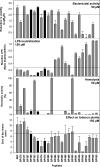Synthetic lipopeptides that interact with lipopolysaccharides are potent bactericidal compounds against Xylella fastidiosa
- PMID: 40736421
- PMCID: PMC12366332
- DOI: 10.1128/aem.00734-25
Synthetic lipopeptides that interact with lipopolysaccharides are potent bactericidal compounds against Xylella fastidiosa
Abstract
Novel strategies to control diseases caused by Xylella fastidiosa that affect important crops like grapevine, olive, almond, and citrus are necessary to prevent its establishment and spread in several countries. Target-oriented functional peptides toward the pathogen are potential new compounds, and peptides directed to lipopolysaccharides (LPS) are suitable candidates. In the present work, 36 peptides, including previously reported sequences and newly synthesized lipopeptides, were studied for their bactericidal and LPS neutralization activities, as well as for their hemolytic and phytotoxic activities. In a first stage, a simple and rapid method for detecting peptide-LPS interactions based on a chromogenic endotoxin assay was developed. A linear relationship was observed between LPS neutralization and the bactericidal activity. A strong LPS interaction was related to a high bactericidal activity, whereas peptides with slight or low interaction with LPS had low bactericidal activity. A selected group of lipopeptides that strongly interacted with the LPS was highly bactericidal with moderate-to-low hemolytic and phytotoxic activity (BP389, BP473, and BP475). These lipopeptides incorporate a butanoyl group at the side chain of a lysine residue and an L- or D-phenylalanine at position 4. The interaction and cell lytic effect between BP473 and X. fastidiosa cells was confirmed by confocal microscopy experiments. These lipopeptides that target key components of the outer bacterial cell membrane are good candidates to mitigate infections by X. fastidiosa in plant hosts.IMPORTANCEXylella fastidiosa is a gram-negative bacterium that affects crops of economic importance such as grapevine, olive, almond, and citrus. The lack of efficient methods to control the diseases caused by this pathogen prompts the research of novel strategies. Since lipopolysaccharides (LPS) are a major virulence factor of X. fastidiosa, the development of new compounds that target LPS constitutes a promising approach. We identified cationic lipopeptides with a strong LPS interaction, high bactericidal activity, and low toxicity. These lipopeptides can be considered good candidates to control X. fastidiosa infections.
Keywords: LPS neutralization; antimicrobial peptides; lipopeptides; lytic effect; plant pathogens.
Conflict of interest statement
The authors declare no conflict of interest.
Figures








Similar articles
-
Prescription of Controlled Substances: Benefits and Risks.2025 Jul 6. In: StatPearls [Internet]. Treasure Island (FL): StatPearls Publishing; 2025 Jan–. 2025 Jul 6. In: StatPearls [Internet]. Treasure Island (FL): StatPearls Publishing; 2025 Jan–. PMID: 30726003 Free Books & Documents.
-
The Black Book of Psychotropic Dosing and Monitoring.Psychopharmacol Bull. 2024 Jul 8;54(3):8-59. Psychopharmacol Bull. 2024. PMID: 38993656 Free PMC article. Review.
-
Sexual Harassment and Prevention Training.2024 Mar 29. In: StatPearls [Internet]. Treasure Island (FL): StatPearls Publishing; 2025 Jan–. 2024 Mar 29. In: StatPearls [Internet]. Treasure Island (FL): StatPearls Publishing; 2025 Jan–. PMID: 36508513 Free Books & Documents.
-
Use of Commercial Fertilizers in an IPDM Protocol to Mitigate Olive Quick Decline Syndrome Caused by Xylella fastidiosa subsp. pauca in Southern Italy.Plant Dis. 2025 Aug 22:PDIS08241770RE. doi: 10.1094/PDIS-08-24-1770-RE. Online ahead of print. Plant Dis. 2025. PMID: 39921346
-
Point-of-care tests for urinary tract infections to reduce antimicrobial resistance: a systematic review and conceptual economic model.Health Technol Assess. 2024 Nov;28(77):1-109. doi: 10.3310/PTMV8524. Health Technol Assess. 2024. PMID: 39644102 Free PMC article.
References
-
- Baker R, Bragard C, Caffier D, Candresse T, Gilioli G. 2015. Scientific opinion on the risks to plant health posed by Xylella fastidiosa in the EU territory, with the identification and evaluation of risk reduction options. EFSA Journal 13:3989. doi: 10.2903/j.efsa.2015.3989 - DOI
-
- Olmo D, Nieto A, Borràs D, Montesinos M, Adrover F, Pascual A, Gost PA, Quetglas B, Urbano A, García J de D, Velasco-Amo MP, Olivares-García C, Beidas O, Juan A, Marco-Noales E, Gomila M, Rita J, Moralejo E, Landa BB. 2021. Landscape epidemiology of Xylella fastidiosa in the Balearic islands. Agronomy 11:473. doi: 10.3390/agronomy11030473 - DOI
-
- Burbank LP. 2022. Threat of Xylella fastidiosa and options for mitigation in infected plants. CABI Rev 17:021. doi: 10.1079/cabireviews202217021 - DOI
MeSH terms
Substances
Supplementary concepts
Grants and funding
LinkOut - more resources
Full Text Sources
Medical

